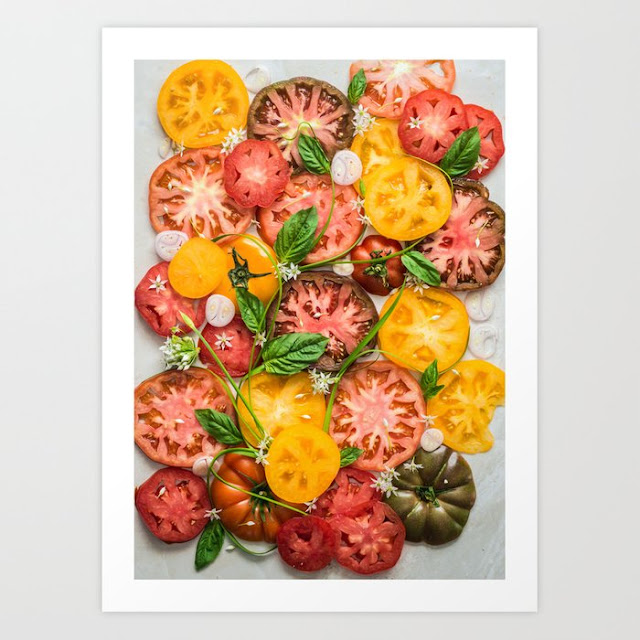Welcome back. As promised, I am writing a post about
heirloom tomatoes. About a month ago I started some from seed. Before I delve into the details of planting, lets take a closer look at heirloom vegetables. Exactly what is a heirloom? I have included 3 highlighted links to Amazon products related to this post for your convenience.
Heirloom Vegetables
According to most sources, an heirloom is an old, open-pollinated variety that is of high quality and easy to grow. As far as how old, some authorities say those vegetables introduced before 1951 qualify as heirlooms, 1951 being the first year hybrid vegetables were developed. Some gardeners prefer even older varieties, as some heirlooms have been passed down for hundreds and even thousands of years.
Open pollinated means that seeds from the vegetable can be grown and will come back exactly the same as the parent plant. A vegetable can only be called an heirloom after proving it remains true year after year. On the other hand, the same is not true for hybrid plants. Therefore seeds from heirlooms can be saved and passed down from generation to generation.
But why are heirlooms so popular? One of the reasons I think is the nostalgic factor. Growing varieties that your parents and/or grandparents grew certainly has an appeal. I enjoy growing vegetable varieties that I remember my parents and grandparents talking about.
The main reason though is the flavor. These old varieties have the true flavor that vegetables should have. The more modern hybrids sometime lack in flavor and studies have shown that in many cases they are also less nutritious.
Hybrid varieties were developed over the years to produce more consistent looking, disease resistant, and higher yielding vegetables, which provide a much better mass appeal in grocery stores ,etc. These are much easier to grow in large quantities with consistent results.
Another advantage to growing heirloom vegetables lies in the ripening process. Hybrids are bred to ripen uniformly, thereby making it much easier to commercially harvest them all at one time. On the other hand, heirlooms tend to ripen more unevenly, which can be advantageous for the home gardener.
With the information I have provided, you should be able to decided whether or not you want to grow heirlooms. I highly recommend it, however I also grow some hybrid varieties as well. They both have their advantages.
Heirloom Hybrid Tomatoes
Heirloom tomatoes are relished for their great flavor, but for some favorites, like Brandywine and Cherokee Purple, there’s a disadvantage. When compared with modern hybrids, heirlooms are not necessarily the most productive or problem-free plants to grow.
Now there are heirloom hybrid tomatoes. No longer true heirlooms, these crosses between two heirloom parents offer the best of both worlds: higher yields, increased disease resistance, often earlier ripening than their parents, plus all of the great flavor of classic heirlooms. So we are back to hybrids, but not as far back as to compromise flavor.
This year I have decided to try some of these heirloom hybrids to see if they are in fact an improvement over just regular hybrids.
Planting Heirloom Hybrid Tomatoes
About a month ago I planted my tomato seeds. I ended up planting 3 heirloom hybrid varieties that I purchased from
Seeds 'N Such.
Cherokee Carbon
From the Seeds 'N Such website:
To capitalize on the current craze, our breeders crossed Cherokee Purple with Carbon to create a robust purple beefsteak with intensely rich flavor. Big, 10 to 12-oz. fruits with a pleasantly sweet taste are the essence of delicious summer eating! Indeterminate. 78 days.
Big Brandy
From the Seeds 'N Such website:
The largest member of the Heirloom Marriage series at 12 to 15-oz., featuring gigantic, meaty, pink beefsteaks. A cross between Brandywine and New Big Dwarf. Flavor is sensational and perfect for fresh salads and sandwiches. Indeterminate. 75 days.
Perfect Flame

From the Seeds 'N Such website:
Earliest to ripen in the series, producing perfectly uniform, blemish-free, 4-oz., saladette fruits of a bright luminous orange. Full-flavored with a delightful balance of sweet and sour. Bred from French heirloom Flammé and Argentine heirloom Peron to produce a stronger, more productive, indeterminate plant than either parent
. 68 days.
In addition to these varieties I also planted the following: Amish Paste and San Marzano (heirloom paste tomatoes), Black Cherry and Matt's Wild Cherry (heirloom cherry tomatoes). These seeds I had leftover from last year. I also planted an experimental tomato which I received with my order from Seeds 'N Such.
Today I transplanted the tomatoes into individual
Jiffy peat pots. This can be done once the plants start developing the second set of leaves. This is an important step in the hardening off process which will be complete once the tomatoes are planted in the garden, sometime around late May. You can see the
original seed starting tray on the left in the photo. I planted about 6 seeds per cell, then of course separated them for transplanting.
When starting seeds, it is not necessary to have them in the sun to germinate, but keeping them in a consistently warm area is important. The container I used has a plastic dome with vents to maintain moisture. Once the seeds sprout, then sun is important. When conditions allowed, I moved the plants to my outdoor greenhouse at least during the day to soak up the sun.
As always, thanks for visiting. In my next post, I will take a break from gardening and will share some more bird photos.















